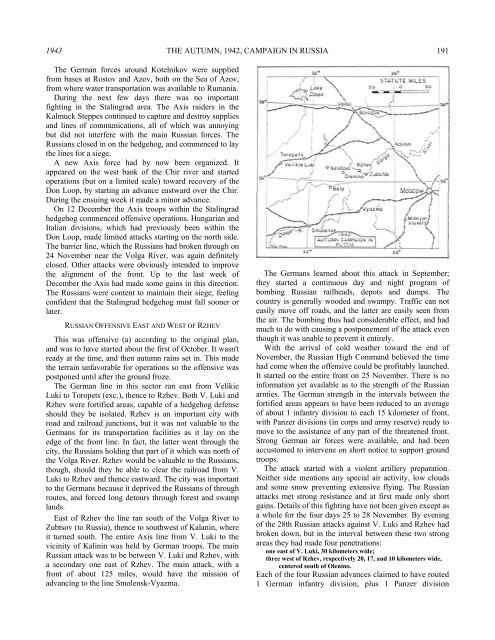the field artillery journal - Fort Sill - U.S. Army
the field artillery journal - Fort Sill - U.S. Army
the field artillery journal - Fort Sill - U.S. Army
You also want an ePaper? Increase the reach of your titles
YUMPU automatically turns print PDFs into web optimized ePapers that Google loves.
1943 THE AUTUMN, 1942, CAMPAIGN IN RUSSIA 191<br />
The German forces around Kotelnikov were supplied<br />
from bases at Rostov and Azov, both on <strong>the</strong> Sea of Azov,<br />
from where water transportation was available to Rumania.<br />
During <strong>the</strong> next few days <strong>the</strong>re was no important<br />
fighting in <strong>the</strong> Stalingrad area. The Axis raiders in <strong>the</strong><br />
Kalmuck Steppes continued to capture and destroy supplies<br />
and lines of communications, all of which was annoying<br />
but did not interfere with <strong>the</strong> main Russian forces. The<br />
Russians closed in on <strong>the</strong> hedgehog, and commenced to lay<br />
<strong>the</strong> lines for a siege.<br />
A new Axis force had by now been organized. It<br />
appeared on <strong>the</strong> west bank of <strong>the</strong> Chir river and started<br />
operations (but on a limited scale) toward recovery of <strong>the</strong><br />
Don Loop, by starting an advance eastward over <strong>the</strong> Chir.<br />
During <strong>the</strong> ensuing week it made a minor advance.<br />
On 12 December <strong>the</strong> Axis troops within <strong>the</strong> Stalingrad<br />
hedgehog commenced offensive operations. Hungarian and<br />
Italian divisions, which had previously been within <strong>the</strong><br />
Don Loop, made limited attacks starting on <strong>the</strong> north side.<br />
The barrier line, which <strong>the</strong> Russians had broken through on<br />
24 November near <strong>the</strong> Volga River, was again definitely<br />
closed. O<strong>the</strong>r attacks were obviously intended to improve<br />
<strong>the</strong> alignment of <strong>the</strong> front. Up to <strong>the</strong> last week of<br />
December <strong>the</strong> Axis had made some gains in this direction.<br />
The Russians were content to maintain <strong>the</strong>ir siege, feeling<br />
confident that <strong>the</strong> Stalingrad hedgehog must fall sooner or<br />
later.<br />
RUSSIAN OFFENSIVE EAST AND WEST OF RZHEV<br />
This was offensive (a) according to <strong>the</strong> original plan,<br />
and was to have started about <strong>the</strong> first of October. It wasn't<br />
ready at <strong>the</strong> time, and <strong>the</strong>n autumn rains set in. This made<br />
<strong>the</strong> terrain unfavorable for operations so <strong>the</strong> offensive was<br />
postponed until after <strong>the</strong> ground froze.<br />
The German line in this sector ran east from Velikie<br />
Luki to Toropets (exc.), <strong>the</strong>nce to Rzhev. Both V. Luki and<br />
Rzhev were fortified areas, capable of a hedgehog defense<br />
should <strong>the</strong>y be isolated. Rzhev is an important city with<br />
road and railroad junctions, but it was not valuable to <strong>the</strong><br />
Germans for its transportation facilities as it lay on <strong>the</strong><br />
edge of <strong>the</strong> front line. In fact, <strong>the</strong> latter went through <strong>the</strong><br />
city, <strong>the</strong> Russians holding that part of it which was north of<br />
<strong>the</strong> Volga River. Rzhev would be valuable to <strong>the</strong> Russians,<br />
though, should <strong>the</strong>y be able to clear <strong>the</strong> railroad from V.<br />
Luki to Rzhev and <strong>the</strong>nce eastward. The city was important<br />
to <strong>the</strong> Germans because it deprived <strong>the</strong> Russians of through<br />
routes, and forced long detours through forest and swamp<br />
lands.<br />
East of Rzhev <strong>the</strong> line ran south of <strong>the</strong> Volga River to<br />
Zubtsov (to Russia), <strong>the</strong>nce to southwest of Kalanin, where<br />
it turned south. The entire Axis line from V. Luki to <strong>the</strong><br />
vicinity of Kalinin was held by German troops. The main<br />
Russian attack was to be between V. Luki and Rzhev, with<br />
a secondary one east of Rzhev. The main attack, with a<br />
front of about 125 miles, would have <strong>the</strong> mission of<br />
advancing to <strong>the</strong> line Smolensk-Vyazma.<br />
The Germans learned about this attack in September;<br />
<strong>the</strong>y started a continuous day and night program of<br />
bombing Russian railheads, depots and dumps. The<br />
country is generally wooded and swampy. Traffic can not<br />
easily move off roads, and <strong>the</strong> latter are easily seen from<br />
<strong>the</strong> air. The bombing thus had considerable effect, and had<br />
much to do with causing a postponement of <strong>the</strong> attack even<br />
though it was unable to prevent it entirely.<br />
With <strong>the</strong> arrival of cold wea<strong>the</strong>r toward <strong>the</strong> end of<br />
November, <strong>the</strong> Russian High Command believed <strong>the</strong> time<br />
had come when <strong>the</strong> offensive could be profitably launched.<br />
It started on <strong>the</strong> entire front on 25 November. There is no<br />
information yet available as to <strong>the</strong> strength of <strong>the</strong> Russian<br />
armies. The German strength in <strong>the</strong> intervals between <strong>the</strong><br />
fortified areas appears to have been reduced to an average<br />
of about 1 infantry division to each 15 kilometer of front,<br />
with Panzer divisions (in corps and army reserve) ready to<br />
move to <strong>the</strong> assistance of any part of <strong>the</strong> threatened front.<br />
Strong German air forces were available, and had been<br />
accustomed to intervene on short notice to support ground<br />
troops.<br />
The attack started with a violent <strong>artillery</strong> preparation.<br />
Nei<strong>the</strong>r side mentions any special air activity, low clouds<br />
and some snow preventing extensive flying. The Russian<br />
attacks met strong resistance and at first made only short<br />
gains. Details of this fighting have not been given except as<br />
a whole for <strong>the</strong> four days 25 to 28 November. By evening<br />
of <strong>the</strong> 28th Russian attacks against V. Luki and Rzhev had<br />
broken down, but in <strong>the</strong> interval between <strong>the</strong>se two strong<br />
areas <strong>the</strong>y had made four penetrations:<br />
one east of V. Luki, 30 kilometers wide;<br />
three west of Rzhev, respectively 20, 17, and 10 kilometers wide,<br />
centered south of Olenino.<br />
Each of <strong>the</strong> four Russian advances claimed to have routed<br />
1 German infantry division, plus 1 Panzer division

















